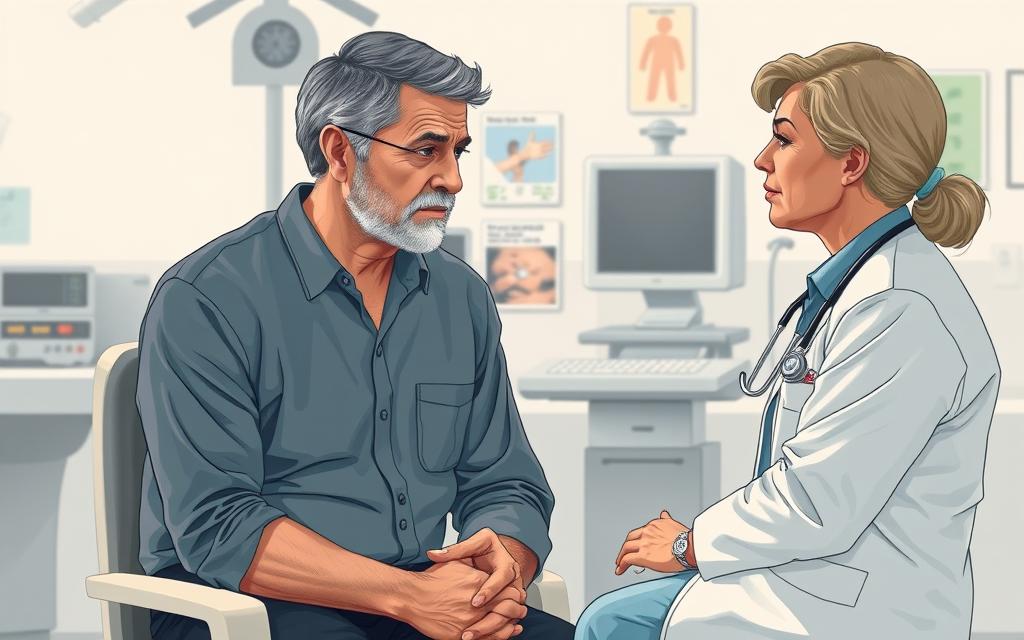Does Prostate Cancer Treatment Cause Erectile Dysfunction? Causes, Risks, and Solutions
Prostate cancer treatment can significantly impact a man’s quality of life, particularly when it comes to sexual health. Treatments for prostate cancer, while lifesaving, can lead to complications such as erectile dysfunction.
Understanding the potential effects of prostate cancer treatment on erectile function is crucial for men facing this diagnosis. The risk of developing erectile dysfunction varies depending on the treatment method, with some treatments having a higher risk than others.
Men undergoing prostate cancer treatment should be aware of the potential risks and discuss solutions with their healthcare provider to mitigate the impact on their sexual health.
Understanding Prostate Cancer and Treatment Options
Understanding the various treatment options for prostate cancer is crucial for patients to make informed decisions. Prostate cancer, like many cancers, comes in different forms, and the type of cancer a patient has can significantly influence the treatment approach.
Common Types of Prostate Cancer
Prostate cancer is primarily classified into types based on the cancer cells’ appearance under a microscope. The most common type is adenocarcinoma, which arises from the glandular cells of the prostate. Other less common types include small cell carcinoma and neuroendocrine tumors.
Standard Treatment Approaches
Treatment for prostate cancer depends on the stage and type of cancer, as well as the patient’s overall health. The main treatment approaches include:
- Surgery
- Radiation Therapy
- Hormone Therapy
Surgery Options
Surgery involves removing the prostate gland and sometimes surrounding tissues. Radical prostatectomy is a common surgical procedure that can be performed using different techniques, including robotic-assisted surgery.
Radiation Therapy Types
Radiation therapy uses high-energy rays to kill cancer cells. The two main types are external beam radiation therapy (EBRT) and brachytherapy, where radioactive material is placed inside the body.
Hormone Therapy
Hormone therapy aims to reduce levels of male hormones (androgens) that fuel prostate cancer growth. This can be achieved through medications or surgery.
How Treatments Affect Surrounding Tissues
Treatments for prostate cancer can impact surrounding tissues and nerves, potentially leading to side effects such as erectile dysfunction. Understanding these risks is crucial for patients to make informed decisions about their care.

The Connection Between Prostate Cancer Treatment and Erectile Dysfunction
The link between prostate cancer treatment and erectile dysfunction is multifaceted, involving various physiological and psychological factors. Prostate cancer treatments, while lifesaving, can have significant side effects, including erectile dysfunction (ED).
How Normal Erectile Function Works
Normal erectile function involves a complex interplay of neurological, vascular, and hormonal mechanisms. The process begins with sexual arousal, which triggers nerve signals to release nitric oxide, causing blood vessels to relax and fill with blood, resulting in an erection.
Mechanisms of Treatment-Induced ED
Treatment-induced ED can result from damage to the nerves and blood vessels surrounding the prostate. This damage can disrupt normal erectile function.
Nerve Damage Pathways
Nerve damage during prostate cancer treatment can occur due to surgical trauma or radiation therapy. The nerves responsible for erectile function are delicate and can be easily damaged, leading to ED.
Vascular Damage Effects
Vascular damage is another mechanism by which prostate cancer treatment can lead to ED. Damage to the blood vessels can reduce blood flow, making it difficult to achieve or maintain an erection.
Statistics on ED After Different Treatments
The incidence of ED varies depending on the type of prostate cancer treatment. Here is a summary of ED statistics after different treatments:
| Treatment Type | Incidence of ED |
|---|---|
| Radical Prostatectomy | 40-80% |
| Radiation Therapy | 30-60% |
| Hormone Therapy | 20-50% |
Understanding these statistics can help men make informed decisions about their treatment options and manage expectations regarding potential side effects like ED.
Specific Treatments and Their Risk Levels for ED
Different prostate cancer treatments have distinct risks of causing erectile dysfunction. Understanding these risks is crucial for men to make informed decisions about their treatment options.
Radical Prostatectomy and Nerve Damage
Radical prostatectomy, or surgical removal of the prostate, is a common treatment for prostate cancer. One of the significant risks associated with this surgery is nerve damage, which can lead to erectile dysfunction.
Traditional vs. Nerve-Sparing Techniques
Traditional surgical techniques may result in higher rates of erectile dysfunction due to the removal or damage of surrounding nerves. In contrast, nerve-sparing techniques aim to preserve these nerves, potentially reducing the risk of ED. Studies have shown that nerve-sparing prostatectomy can significantly improve erectile function recovery.
Recovery Timeline After Surgery
The recovery timeline for erectile function after radical prostatectomy varies among individuals. Generally, some men may experience a return of erectile function within several months to a year after surgery, while others may take longer. Factors influencing recovery include age, preoperative erectile function, and the extent of nerve preservation.
Radiation Therapy Effects
Radiation therapy is another treatment modality for prostate cancer, which can also impact erectile function. The risk of ED varies depending on the type of radiation therapy used.
External Beam Radiation
External beam radiation therapy (EBRT) involves directing radiation from outside the body to the prostate. While effective, EBRT can cause vascular damage and affect erectile function over time. The risk of ED increases with higher doses of radiation and longer treatment durations.
Brachytherapy (Seed Implants)
Brachytherapy involves placing radioactive seeds directly into the prostate. This method can minimize damage to surrounding tissues, potentially reducing the risk of ED compared to EBRT. However, the risk is still present and can increase over time.

Hormone Therapy Impact
Hormone therapy, used to reduce testosterone levels, can also affect erectile function. Lower testosterone levels can lead to decreased libido and erectile dysfunction. The impact of hormone therapy on ED can vary, and some men may experience a return of erectile function after treatment cessation.
Active Surveillance and Watchful Waiting
For men with low-risk prostate cancer, active surveillance or watchful waiting may be recommended. These approaches involve monitoring the cancer rather than immediate treatment, potentially avoiding or delaying treatment-related side effects like ED.
In conclusion, the risk of erectile dysfunction varies among different prostate cancer treatments. Understanding these risks and discussing them with a healthcare provider can help men make informed decisions about their care.
- Radical prostatectomy carries a risk of nerve damage and ED.
- Nerve-sparing techniques can reduce this risk.
- Radiation therapy, including EBRT and brachytherapy, can cause ED.
- Hormone therapy affects erectile function by reducing testosterone.
- Active surveillance may be an option for avoiding treatment-related ED.
Solutions and Management Strategies for Treatment-Induced ED
Addressing erectile dysfunction post-prostate cancer treatment involves a combination of medical and lifestyle adjustments. Men who experience ED after treatment can explore various effective management strategies to regain their sexual health and intimacy.
Medical Interventions
Medical interventions play a crucial role in managing ED. These include:
Oral Medications (PDE5 Inhibitors)
Oral medications such as sildenafil (Viagra), tadalafil (Cialis), and vardenafil (Levitra) are commonly prescribed to treat ED. These drugs work by enhancing blood flow to the penis, facilitating an erection.
Injectable Therapies
For some men, injectable therapies like alprostadil can be effective. This involves injecting a medication directly into the penis to induce an erection.
Vacuum Devices and Penile Implants
Vacuum erection devices are another option, using a vacuum pump to draw blood into the penis. For more severe cases, penile implants can be considered, involving surgical placement of a device that enables erection.
Penile Rehabilitation Programs
Penile rehabilitation programs are designed to help restore erectile function after prostate cancer treatment. These programs often combine various treatments, including medications and devices, to promote recovery.
Psychological Support and Counseling
ED can have a significant psychological impact. Counseling and psychological support can help men cope with the emotional aspects of ED, improving overall well-being and relationship satisfaction.
Partner Communication and Intimacy Alternatives
Open communication with a partner about ED and exploring intimacy alternatives can strengthen relationships. Couples can find new ways to be intimate and maintain a fulfilling sexual relationship.
Lifestyle Factors That May Help Recovery
Lifestyle adjustments such as regular exercise, a healthy diet, quitting smoking, and reducing alcohol consumption can positively impact erectile function. These changes can complement medical treatments, enhancing overall recovery.
Conclusion: Making Informed Decisions About Prostate Cancer Treatment
Understanding the potential risks of erectile dysfunction (ED) associated with prostate cancer treatment is crucial for making informed decisions. A meta-analysis of clinical trials showed that the incidence of ED in finasteride-treated patients ranged from 2% to 15%, with the risk being higher in the initial stages of treatment.
Age and existing health conditions, such as diabetes and cardiovascular disease, can increase the risk of side effects. Patients should be aware of the potential risks and benefits of treatment options and discuss concerns with their healthcare provider to determine the best course of treatment for their prostate cancer.
By considering both the effectiveness of the treatment and its potential impact on quality of life, patients can make informed decisions about their prostate cancer treatment.
